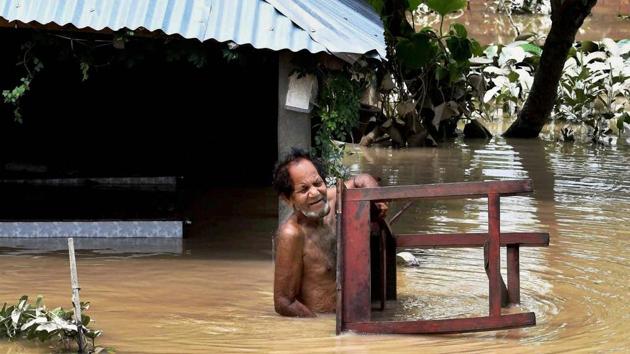Bihar floods: State looks at new plans to combat an old enemy
With climate change making monsoons more intense and floods harder to predict, state govts are struggling to recalibrate their disaster management plans
Twenty four hours into Bihar’s worst flood in a decade, the residences of the collector and superintendent of police were under eight feet of water. The district administration collapsed, electricity and cellphone networks were knocked out, vital road links snapped and communication with the flood control centre in Patna were severed.

“People were stranded and starving,” said Shiv Narain of the Jan Jagaran Shakti Sangathan. “The administration did not have enough boats, private boatmen were charging to transport people and their possessions.” When the waters finally receded, villagers like Bikram Singh made flimsy rafts to fish out the bloated corpses of beloved friends and family members who had drowned in the swirling waters.
“I pulled out 18 bodies myself,” said Singh, a resident of Jogbani, a settlement that bore the brunt of the flood. “I couldn’t bear to touch food with my hands for a week.” Two of these bodies were Nemua Yadav, and his 13 year-old daughter Pooja.
“The administration couldn’t help me,” said Ranju Devi, Yadav’s elder daughter who survived. “In such a big country, they couldn’t find a boat? What kind of government is this?”
Floods have claimed 6,028 lives in Bihar since 2000 - not a year has passed without casualties in some part of the state. Now, scientists say climate change is making monsoons more intense and floods harder to predict; which means state governments like Bihar’s are struggling to recalibrate their disaster management plans. As this largely rural state urbanises, state officials say they are revisiting major construction projects, city plans and road works to in light of their possible effect on floods. The administration had boats, just not in Jogbani.
“On the morning of August 11, Araria was preparing to deal with a possible drought with a rainfall 39% below normal,” said Principal Secretary Pratyaya Amrit, who oversaw flood mitigation and relief efforts, “Twenty four hours later we were hit by the worst flood in a decade.”
Ninety five of the 514 people who died in the 2017 floods, the worst in a decade, were from Araria. Amrit admits that the intensity of the flood in Araria caught the government unawares, but say they worked hard to restore communication and road links, position relief personnel and run community kitchens. Some experts like Dinesh Kumar Mishra, a engineer who has written extensively on the floods, believe that the crisis is partly due to past mitigation efforts - in particular the construction of over 3,000 km worth of flood embankments to contain Bihar’s rivers.
Bihar’s rivers, Mishra said, carry large amounts of sediment which is usually spread over a large area when the river floods. When contained between embankments, this sediment is deposited along the river bed.
“This raises the level of the river, so you make taller embankments, which are less stable,” said Mishra. In 2008 for instance, the Kosi river breached its embankment, triggering a flood that killing 489 people in two adjoining districts of Supaul and Madhepura, and 626 people across the state. This year too, the Gandak river breached its banks in eight places in north-western Bihar, where 138 people died. “Its like you have a cat, then you turn it into a tiger, then you don’t know how to fight the tiger,” Mishra said. As Bihar urbanised, he said it was perhaps to plan cities that anticipated an annual flood, rather than attempted to prevent it. “The embankments are not working, so why not draw lessons from East Asian cities where homes and essential services are built on stilts?”
Amrit, the Principal Secretary, said the government was looking to make the state’s infrastructure flood resistant. When the rains stopped, raised highways, railway lines, and village-level check-dams meant the water had nowhere to go. The highways became sites of refuge, but they also exacerbated the flood by turning low-lying areas into vast lakes spanning hundreds of acres.
“We have to ensure enough cross-drainage for all raised infrastructure like roads, and railways,” Amrit said.
The government has plans to build community centres on stilts in each panchayat to provide a safe refuge in the countryside, with ramps leading up to the roof of the building for villagers to keep their cattle safe.
“We are going to provide satellite phones to our collectors,” he said, “The most important lesson is that in a disaster, we need to maintain all lines of communication.”





